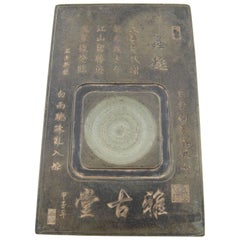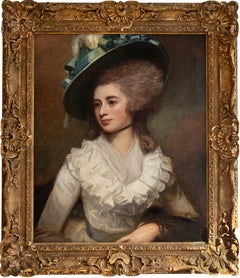Antique Ming Dynasty Chinese Inkstone
16th Century Chinese Chinoiserie Antique Ming Dynasty Chinese Inkstone
Stone
People Also Browsed
1970s Old Masters Antique Ming Dynasty Chinese Inkstone
Canvas, Oil
17th Century Italian Baroque Antique Ming Dynasty Chinese Inkstone
Spruce
19th Century French Chinoiserie Antique Ming Dynasty Chinese Inkstone
Ormolu
17th Century Chinese Ming Antique Ming Dynasty Chinese Inkstone
Bronze
Late 19th Century Chinese Qing Antique Ming Dynasty Chinese Inkstone
Pottery
Early 20th Century Chinese Antique Ming Dynasty Chinese Inkstone
Coral
15th Century and Earlier Chinese Tang Antique Ming Dynasty Chinese Inkstone
Pottery
15th Century and Earlier Chinese Han Antique Ming Dynasty Chinese Inkstone
Bronze
19th Century Chinese Chinese Export Antique Ming Dynasty Chinese Inkstone
Paint
Early 1700s Chinese Qing Antique Ming Dynasty Chinese Inkstone
Enamel
Late 19th Century Chinese Qing Antique Ming Dynasty Chinese Inkstone
Porcelain
15th Century and Earlier Chinese Archaistic Antique Ming Dynasty Chinese Inkstone
Bronze
15th Century and Earlier Chinese Han Antique Ming Dynasty Chinese Inkstone
Terracotta
Early 20th Century Chinese Han Antique Ming Dynasty Chinese Inkstone
Jade
15th Century and Earlier Chinese Han Antique Ming Dynasty Chinese Inkstone
Terracotta
Early 20th Century Japanese Taisho Antique Ming Dynasty Chinese Inkstone
Bronze
A Close Look at chinoiserie Furniture
Emerging in the 17th century, chinoiserie appropriated the aesthetics and imagery of popular East Asian design for European-made versions. Reflecting the exoticization of China, Japan and other countries in this era, the word directly translates from French to “Chinese-esque,” which reveals its shortcomings as a style of furniture and decor that often stereotypically and reductively mimics Asian culture rather than showcasing and paying tribute to its artistic traditions.
The enthusiastically decorative chinoiserie style was propelled by influential tastemakers including French King Louis XIV, whose Trianon de Porcelaine in 1670 was inspired by Chinese architecture. Expanded trade between the East and West led to a demand for porcelain, lacquer objects, silk and other goods, which further informed the fanciful furniture being crafted in Europe.
Artisans working in the chinoiserie style used materials and elements like pagoda shapes, bamboo, lacquer surfaces, bird and flower motifs and other interpretations of Asian design on pieces that were frequently set against vibrant wallcoverings. This whimsical approach yielded chinoiserie furniture that boasted dramatic flourishes drawing on the natural world and reflected the dominance of Rococo during the 18th century.
As chinoiserie was shaped by approximations of Asian design by European creators, it had regional variations, such as Chinese Chippendale in England where cabinets, chairs and tea tables had wooden fretwork designs and “japanned” surfaces intended to resemble lacquer work that was created in East Asia. In North America, furniture makers in Boston and New York integrated chinoiserie-painted scenes into Queen Anne furniture.
Antique chinoiserie furniture has continued to be fashionable, from its popularity with decorators of the Hollywood Regency era — James Mont, Tommi Parzinger, William Haines and Samuel Marx favored the style — to contemporary interior designers, although it brings with it a complex history.
Find a collection of chinoiserie bedroom furniture, cabinets, decorative objects and more on 1stDibs.
Finding the Right asian-art-furniture for You
From Japanese handmade earthenware pottery, originating circa 14,500 B.C. and adorned with elaborate corded patterns known as jōmon, to natural elm case pieces and storage cabinets built in Qing dynasty–era China to mid-century Thai rice-paper charcoal rubbings, antique and vintage Asian art and furniture make for wonderful additions to all kinds of contemporary interiors.
Eastern elements elevate any home’s decor. Introduce zen sensibility to your living room, dining room and bedroom with the neutral color palettes and the natural materials such as rattan, bamboo and elm that we typically associate with traditional Asian furniture. Decorative handwoven embroideries and textiles originating from India and elsewhere on the continent, which can be draped over a bed or sofa or used as a wall hanging, can be as practical as they are functional, just as you wouldn’t seek out Japanese room-divider screens — often decorated with paintings but constructed to be lightweight and mobile — merely for privacy.
With everything from blanket chests to lighting fixtures to sculptures and carvings, it’s easy to tastefully bring serenity to your living space by looking to the treasures for which the East has long been known.
For British-born furniture designer Andrianna Shamaris, the Japanese concept of beauty in imperfection isn’t limited to her Wabi Sabi collection. She embraces it in her New York City apartment as well. In the living area, for instance, she retained the fireplace’s original black marble while swathing its frame and the rest of the room in bright white.
“We left the fireplace very clean and wabi-sabi, so that it blended into the wall,” says Shamaris, who further appointed the space with a hand-carved antique daybed whose plush pillows are upholstered in antique textiles from the Indonesian island of Sumba.
In the growing antique and vintage Asian art and furniture collection on 1stDibs, find ceramics from China, antiquities from Cambodia and a vast range of tables, seating, dining chairs and other items from Japan, India and other countries.


